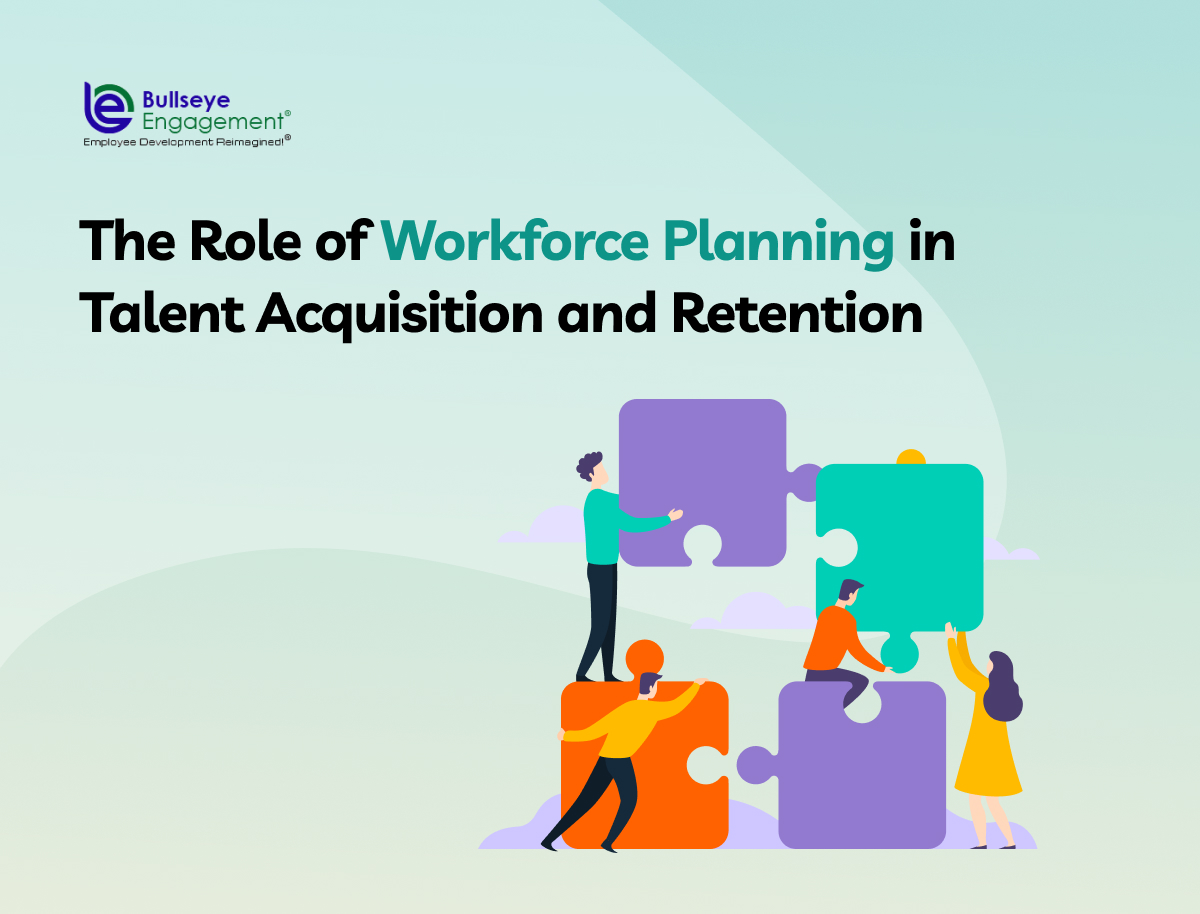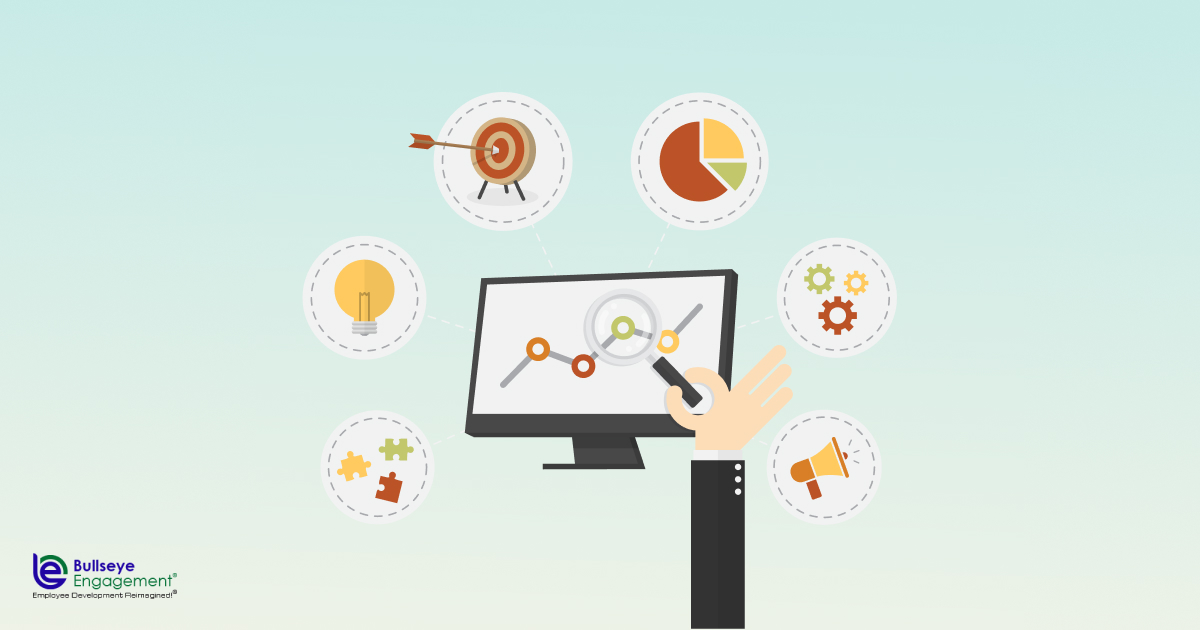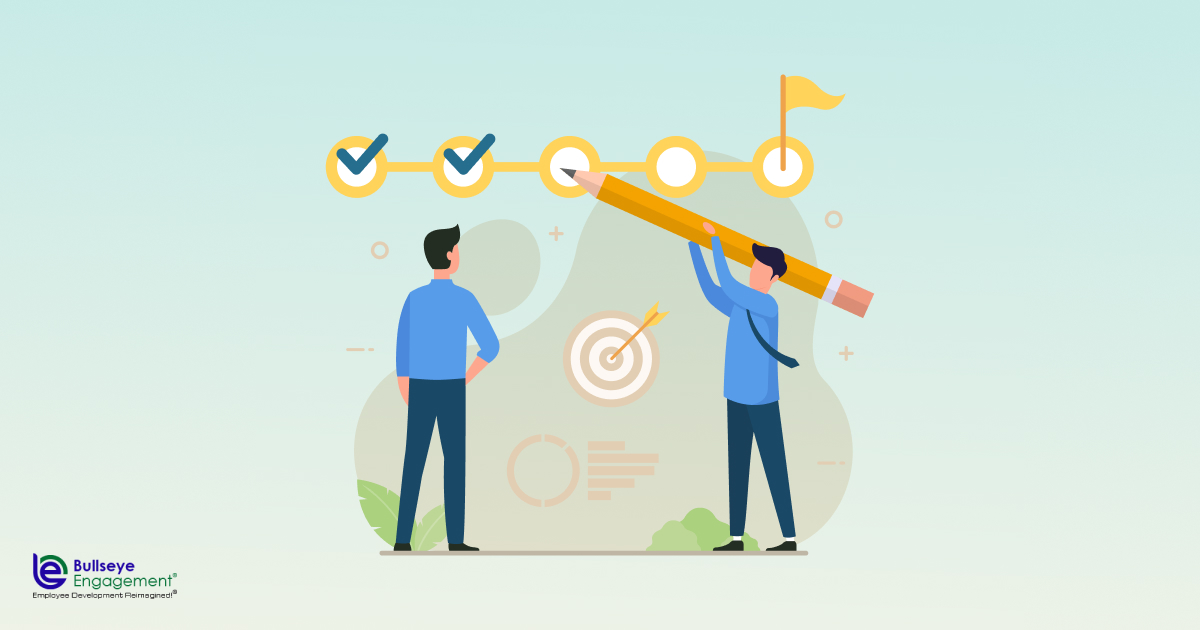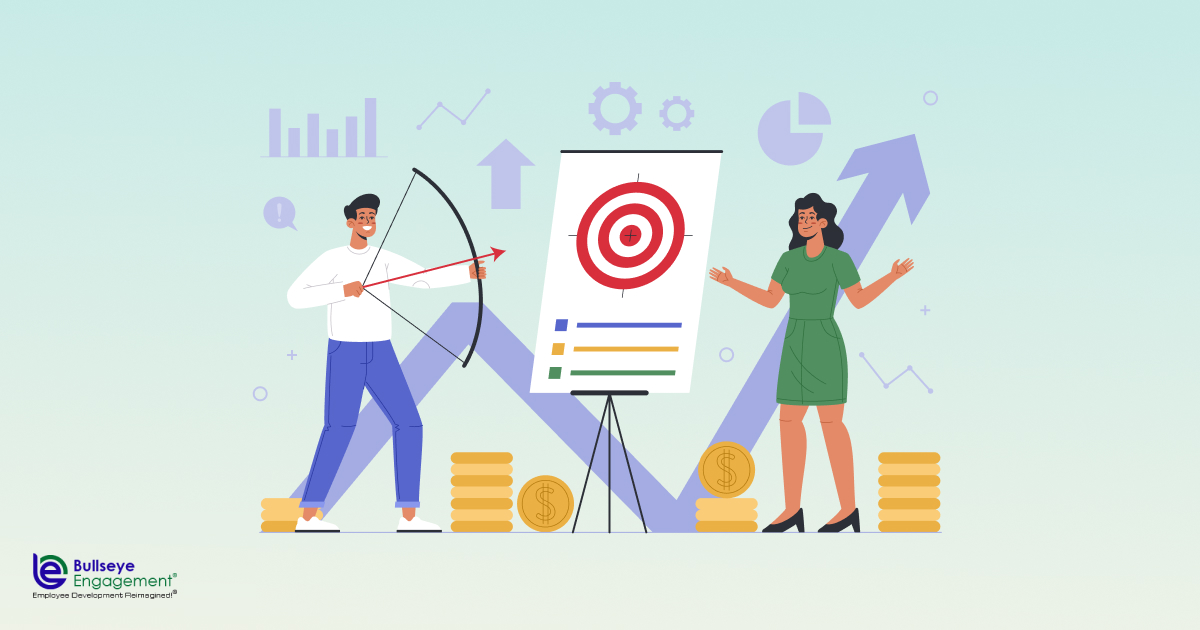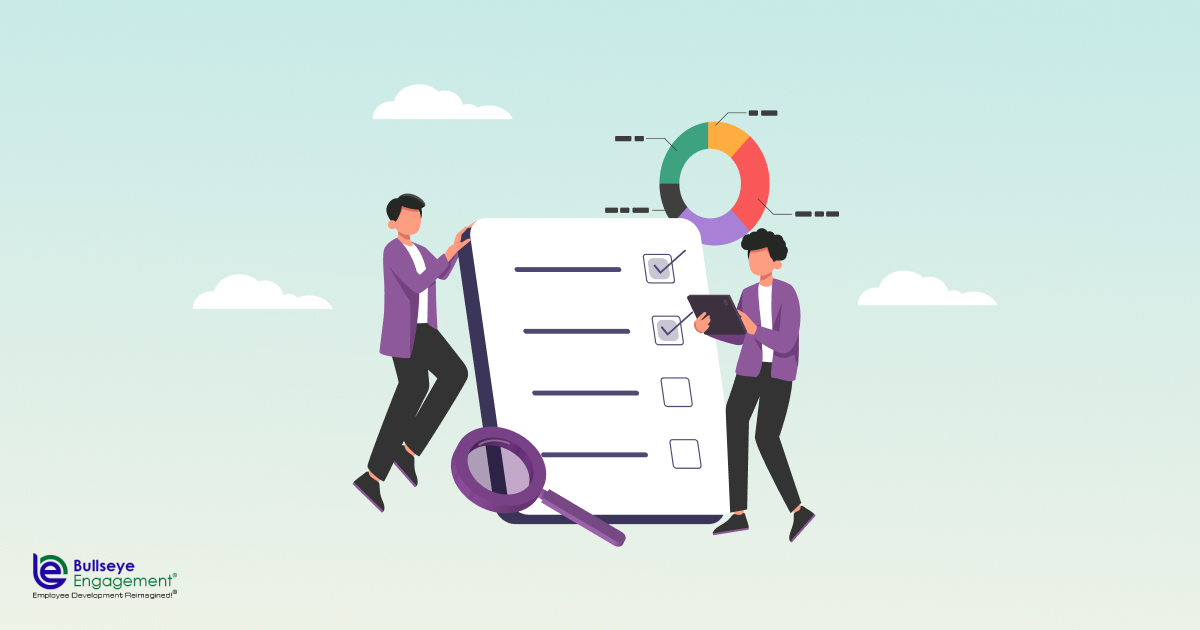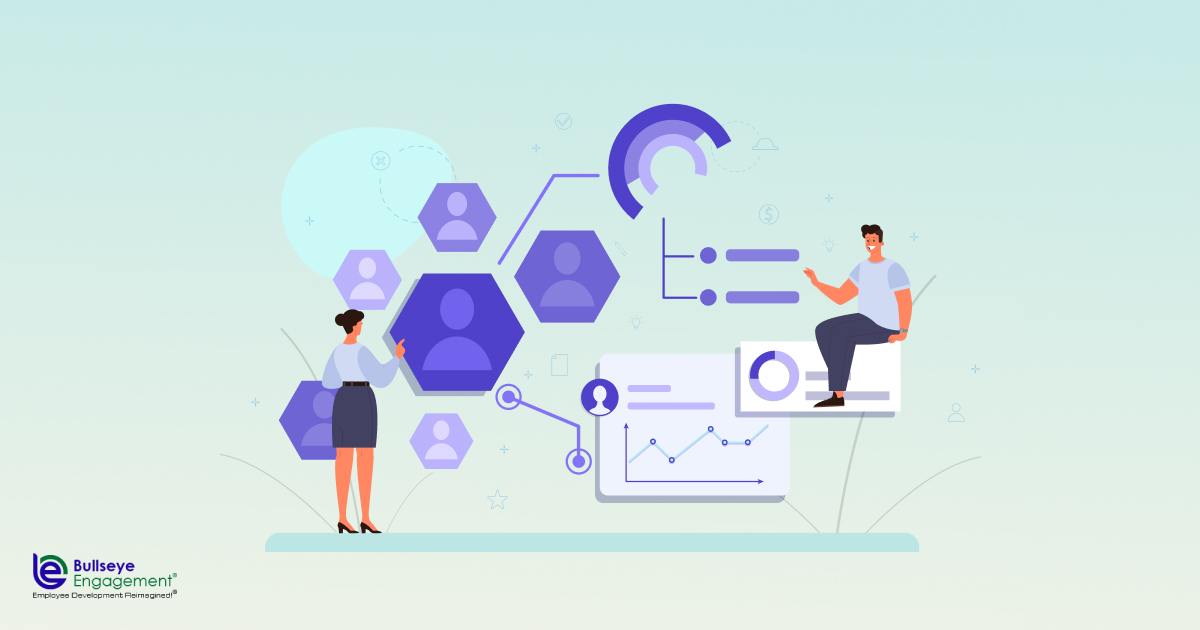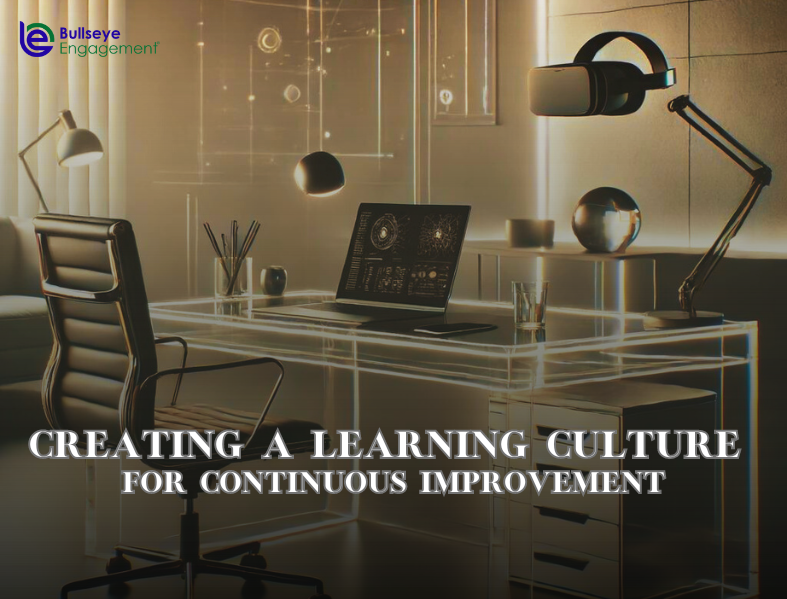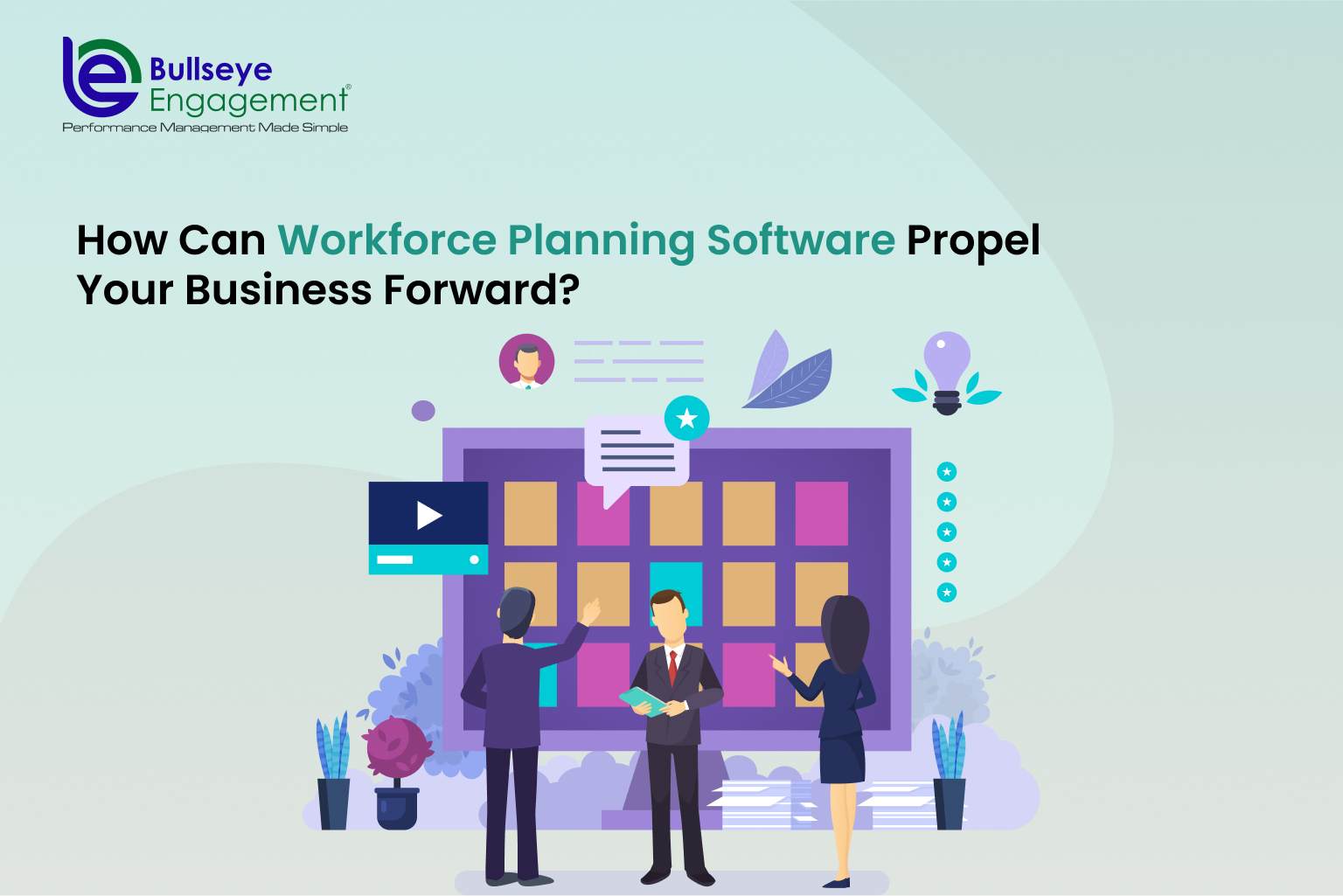Undoubtedly Talent Acquisition is one of the most important sections of any business, and if you’re wondering what is the role of workforce planning here, then BullseyeEngagement is here to explain that to you!
Read this blog to understand the role of workforce planning in Talent Acquisition and Retention.
One of the most crucial factors contributing to an organization’s success is its ability to attract, acquire, and retain top-tier talent. This is where the intricate interplay of workforce planning comes into play.
Workforce planning, often hailed as a cornerstone of effective human resource management, goes beyond the conventional scope of recruiting and retaining employees. It encompasses a comprehensive approach that aligns an organization’s human capital strategy with its long-term business objectives. At the heart of this practice lies the synchronization of talent acquisition and retention efforts, creating a seamless cycle that ensures the right people are in the right roles at the right time.
In this blog, we delve into the multifaceted realm of workforce planning and its pivotal role in the realm of talent acquisition and retention. We will explore how strategic planning, data-driven insights, and forward-thinking methodologies combine to not only fill current workforce gaps but also anticipate future needs. Join us as we uncover the strategies that enable businesses to build a workforce that’s not only prepared for the present but poised for sustainable growth.
Whether you’re a seasoned HR professional, a business leader, or an aspiring talent management enthusiast, the insights shared here will offer you a deeper understanding of how effective workforce planning can reshape the trajectory of talent acquisition and retention strategies. So, let’s embark on this journey to unravel the intricacies of workforce planning and discover how it can be leveraged to attract, nurture, and retain the best-in-class talent that drives organizational excellence.
Table of Content
- Aligning Talent Acquisition with Organizational Goals
- Anticipating Future Needs through Data-Driven Insights
- Importance of Clear Organizational Goals and Objectives
- Characteristics of Effective Organizational Goals and Objectives
- Process of Defining Organizational Goals and Objectives
- Strategic Workforce Planning
- Developing Targeted Recruitment Strategies
- Assessing for Cultural Fit and Skills Alignment
- Cultural Fit Evaluation
- Skills Alignment Assessment
- Behavioral Interviewing Techniques
- Conclusion
Aligning Talent Acquisition with Organizational Goals
Defining Organizational Goals and Objectives
Successful talent acquisition and retention begin with a clear understanding of an organization’s goals and objectives. These goals serve as the guiding light that shapes the type of talent needed to drive the company forward. Workforce planning starts by collaborating closely with leadership and stakeholders to define short-term and long-term goals. Whether the aim is to expand into new markets, innovate products, or enhance operational efficiency, these objectives provide the foundation upon which the talent strategy is built.
Strategic Workforce Planning
Strategic workforce planning involves translating these organizational goals into actionable talent acquisition plans. This entails identifying the skills, competencies, and roles required to achieve those objectives. By mapping out the future workforce needs, organizations can anticipate potential talent gaps and proactively address them. This also involves analyzing internal talent pipelines, understanding turnover rates, and identifying critical positions that require specialized expertise.
Developing Targeted Recruitment Strategies
Once the workforce requirements are clearly defined, it’s time to develop targeted recruitment strategies. Generic job postings are replaced by specific, tailored descriptions that outline the qualifications, experience, and qualities required. These strategies may involve leveraging multiple recruitment channels, including online job boards, social media platforms, and professional networks. Strategic partnerships with educational institutions and industry associations can also yield a pipeline of fresh talent aligned with the organization’s needs
Assessing for Cultural Fit and Skills Alignment
As candidates flow into the recruitment funnel, assessing them for both cultural fit and skills alignment becomes pivotal. Cultural fit ensures that new hires resonate with the organization’s values, mission, and working environment, promoting a cohesive and productive team. Simultaneously, evaluating candidates’ skills and competencies against the outlined requirements ensures that they are equipped to contribute effectively from day one. Incorporating a mix of behavioral interviews, skill assessments, and scenario-based evaluations aids in making well-informed hiring decisions.
Continuous Monitoring and Adaptation
In the fast-paced business landscape, workforce dynamics can change rapidly. Therefore, continuous monitoring and adaptation are vital components of aligning talent acquisition with organizational goals. Regularly revisiting the workforce plan, evaluating its effectiveness, and making necessary adjustments ensure that the talent strategy remains relevant. This involves staying attuned to market trends, technological advancements, and shifts in industry demand. Adapting the talent acquisition approach based on real-time insights enhances agility and ensures a sustained alignment with organizational goals.
Anticipating Future Needs through Data-Driven Insights
Anticipating Future Needs through Data-Driven Insights
In the dynamic landscape of talent acquisition and retention, organizations must be proactive in their approach. Anticipating future needs and aligning talent strategies with business objectives is no longer a luxury; it’s a necessity. This is where data-driven insights come into play, guiding organizations toward informed decisions that strengthen their workforce planning.
Importance of Clear Organizational Goals and Objectives
Clear organizational goals and objectives serve as the North Star for effective workforce planning. When these goals are well-defined and closely aligned with the overall business strategy, they provide a framework for talent acquisition and retention efforts. Every hire, every development initiative, and every retention strategy can then be directed toward supporting these objectives, ensuring that the workforce remains a powerful asset driving the company forward.
Characteristics of Effective Organizational Goals and Objectives
Effective organizational goals and objectives exhibit several key characteristics. They are:
1. Specific: They are precise and clearly defined, leaving no room for ambiguity.
2. Measurable: They come with quantifiable metrics that allow progress tracking and success measurement.
3. Attainable: While ambitious, they remain achievable with the right strategy and effort.
4. Relevant: They directly contribute to the overarching business strategy and reflect the company’s current and future needs.
5. Time-Bound: They have a well-defined timeline for accomplishment, preventing complacency and encouraging action.
Process of Defining Organizational Goals and Objectives
The process of defining organizational goals and objectives is a strategic endeavor that requires thoughtful consideration and collaboration. It typically involves these steps:
1. Business Analysis: Begin with a comprehensive analysis of the company’s current state, identifying strengths, weaknesses, opportunities, and threats.
2. Stakeholder Engagement: Involve key stakeholders from different departments to gather insights and ensure alignment.
3. Goal Formulation:Based on the analysis and stakeholder input, formulate high-level goals that address critical areas such as growth, innovation, and operational excellence.
4. Objective Creation:Break down each goal into specific, measurable objectives.These objectives will guide your talent acquisition and retention strategies.
5. Data Collection:Leverage data sources such as performance metrics, turnover rates, and market trends to inform the feasibility and impact of each objective
6. Continuous Review:Regularly review and refine your goals and objectives based on changing business dynamics and emerging opportunities.
Strategic Workforce Planning
In the ever-evolving landscape of business, talent acquisition and retention have emerged as critical factors that can make or break an organization’s success. Companies are realizing that to stay competitive and agile, they must not only attract top-tier talent but also strategically plan how to retain and optimize their workforce. This is where Strategic Workforce Planning steps in as a game-changer.
Importance of Strategic Workforce Planning
Strategic Workforce Planning is more than just filling job openings; it’s a comprehensive approach to aligning your organization’s human capital with its overall business strategy. It involves forecasting talent needs, identifying skill gaps, and creating a roadmap to ensure that your workforce is not just sufficient, but equipped to drive innovation and growth.
By engaging in Strategic Workforce Planning, organizations can:
Anticipate Future Needs: Proactively identify the skills and competencies that will be vital to your organization’s success in the future, allowing you to stay ahead of industry trends and market shifts.
Enhance Agility: Build a workforce that can adapt to changing demands and seize new opportunities, maintaining your company’s ability to pivot and thrive.
Mitigate Risks: Minimize disruptions by having a robust plan in place to address workforce gaps and potential talent shortages.
Boost Engagement and Retention: A well-thought-out plan demonstrates your commitment to employee growth and development, leading to higher job satisfaction and reduced turnover.
Key Components and Considerations in Workforce Planning
1. Data-Driven Insights: Strategic Workforce Planning begins with a deep dive into workforce analytics. Identify key metrics such as turnover rates, employee performance, and succession planning data to inform your strategy.
2. Alignment with Business Goals: Your workforce plan should seamlessly align with your organization’s overall goals and objectives. Consider how your workforce can contribute to achieving these goals.
3. Skill Mapping: Map out the skills and competencies required for each role within your organization. Identify gaps between current skills and future needs.
4. Talent Pipeline: Develop a talent pipeline that nurtures internal talent and strategically sources external talent when needed.
5. Scenario Planning: Anticipate different scenarios that could impact your workforce, such as growth, downsizing, or industry shifts, and plan accordingly.
Implementing Effective Strategic Workforce Planning Strategies
1. Engage Leadership: Secure buy-in from leadership, as Strategic Workforce Planning requires commitment and support from the top.
2. Collaborative Approach: Involve HR, department heads, and other stakeholders to ensure a holistic view of workforce needs.
3. Continuous Review: Workforce Planning is not a one-time endeavor. Regularly review and adjust your strategy to stay aligned with changing business conditions.
4. Leverage Technology: Utilize workforce planning tools and software to streamline data analysis, scenario modeling, and reporting.
5. Invest in Development: Provide training and development opportunities that bridge skill gaps and promote career growth within the organization.
Developing Targeted Recruitment Strategies
Here’s how BullseyeEngagement excels in developing such strategies:
Market Research and Analysis
Effective workforce planning starts with a deep understanding of the talent market. Our team at BullseyeEngagement conducts thorough market research and analysis to identify trends, skill gaps, and emerging demands in your industry. By pinpointing the evolving needs of job seekers, we help you align your recruitment efforts with the expectations of top-tier candidates.
Through our research-driven approach, we identify where the most sought-after talents are, what motivates them, and how they engage with potential employers. This knowledge serves as the foundation for crafting recruitment strategies that not only attract but also resonate with the talent you’re seeking.
Tailored Messaging and Communication
In a world inundated with recruitment messages, standing out requires more than just a generic job posting. BullseyeEngagement understands the significance of tailored messaging in capturing the attention of potential candidates. We craft compelling job descriptions, employer branding narratives, and communication that speak directly to the aspirations and goals of the talent you’re targeting.
Our approach involves aligning your company’s unique value proposition with the career goals of potential candidates. Whether it’s highlighting growth opportunities, company culture, or work-life balance, we ensure that your messaging resonates with the right individuals, prompting them to take the next step in their journey with your organization.
Engagement and Relationship Building
Recruitment doesn’t end once a candidate accepts an offer. In fact, that’s where the journey truly begins. BullseyeEngagement emphasizes the importance of engagement and relationship-building throughout the talent acquisition process. We understand that fostering connections with candidates not only enhances their onboarding experience but also contributes to long-term retention.
Our team maintains open lines of communication with candidates from the moment they express interest. We provide personalized touchpoints, address their queries, and guide them through the transition process. This level of engagement not only ensures a smooth integration into your company but also nurtures a sense of belonging and commitment that extends beyond the initial onboarding phase.
Cultural Fit Evaluation
Cultural fit: It refers to the alignment of a candidate’s values, beliefs, and work style with the company’s core culture and values. A strong cultural fit contributes to employee satisfaction, engagement, and long-term success within the organization. To assess cultural fit, we employ a combination of methods:
Company Values Alignment: We gauge how well a candidate’s personal values align with the company’s stated values and mission. This alignment fosters a sense of purpose and belonging.
Behavioral Assessment: We assess whether a candidate’s behaviors and attitudes resonate with the desired cultural traits, promoting a harmonious workplace environment.
Team Compatibility: We consider how well a candidate is likely to collaborate with existing team members, ensuring a cohesive and collaborative workforce.
Skills Alignment Assessment
Skills alignment entails evaluating a candidate’s technical competencies and capabilities to determine if they possess the skills necessary to excel in the role they’re being considered for. This assessment is pivotal in ensuring that new hires can make immediate contributions to the organization. Our approach to skills alignment includes:
Job-Specific Skills: We evaluate the candidate’s proficiency in the specific skills and tools required for the role, minimizing the learning curve and accelerating productivity.
Adaptability: We assess a candidate’s ability to adapt their existing skill set to new challenges and evolving job demands, enabling them to thrive in a dynamic environment.
Future Skills: We also consider a candidate’s potential for growth and development, ensuring that their skills are aligned with the organization’s future needs.
Behavioral Interviewing Techniques
Our skilled interviewers use behavioral interviewing to:
Uncover Real-life Scenarios: We ask candidates to provide specific examples of how they’ve handled challenges and situations relevant to the role, shedding light on their problem-solving and decision-making abilities.
Assess Soft Skills: Through behavioral questions, we assess essential soft skills such as communication, leadership, teamwork, and conflict resolution.
Predict Future Performance: By understanding how candidates have behaved in similar circumstances, we can make more informed predictions about their potential performance within our organization.
Conclusion
In the fast-paced and competitive landscape of today’s business world, effective talent acquisition and retention strategies are essential for an organization’s success. As we’ve explored in this blog, workforce planning is not just about filling gaps or managing headcount—it’s a holistic approach that aligns business objectives with human capital needs. By anticipating skill requirements, identifying potential talent shortages, and nurturing the growth of existing employees, organizations can mitigate risks and seize opportunities.
Talent acquisition and retention are two sides of the same coin, and a well-executed workforce planning strategy bridges the gap between them. At BullseyeEngagement, we understand the significance of workforce planning in achieving your organizational goals. Our comprehensive suite of workforce management solutions is designed to support your talent acquisition, development, and retention initiatives. Let’s work together to build a workforce that propels your business toward excellence.















